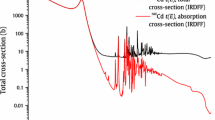Abstract
This work concerns the underestimation of the errors in the recommended neutron cross sections obtained by using strict statistical methods to analyze measurements. It is shown that one reason for this is inadequate representation of the initial experimental data, specifically, correlations of the experimental data are neglected. The effect of correlations of the experimental data on the error in the evaluated neutron cross sections is studied using realistic models and practical examples. Special attention is focussed on correlations of measurements performed by different authors. Analysis of correlations of this kind substantially increases the errors in the evaluated cross sections. Analysis of the model examples shows that the correction can be large (∼70%) even for cases with relatively weak correlation of the measurements performed by different authors. For the evaluated cross sections of the reactions103Rh(n, n′)103mRh and237Np(n, f) the corrections reach 41% and 25% for certain energy ranges. 5 figures, 1 table, 22 references.
Similar content being viewed by others
References
H. Conde (ed.),Nuclear Data Standards for Nuclear Measurements, OECD, Paris (1992).
D. Santry and R. Werner, “Cross sections for the93Nb(n, 2n)92mNb reaction,”Can. J. Phys.,68, 582–586 (1990).
S. Tagesen, H. Vonach, S. A. Badikov, and V. G. Pronyaev, “Evaluation of fast neutron cross sections and covariants matrices of52Cr,” in:Proceedings of the International Conference on Nuclear Data for Science and Technology, May 9–13, 1994, Gatlinburg, USA, pp. 620–623.
S. Oh and K. Shibata, “Evaluation of covariance data for chromium, iron, and nickel contained in JENDL-3.2,”J. Nucl. Sci. Tech.,35, No. 1, 66–75 (1998).
S. A. Badikov, V. N. Vinogradov, E. V. Gai, and N. S. Rabotnov, “Analytic fit of data in neutron physics,”At. Énerg.,56, No. 1, 20–25 (1984).
S. A. Badikov, “Statistical analysis of correlated experimental data and evaluation of neutron cross sections,”ibid.,84, No. 5, 426–434 (1998).
Ch. Konno, Yu. Ikeda, K. Oishi, et al., “Activation cross section measurements at neutron energy from 13.3 to 14.9 MeV using the FNS facility,”Rep. JAERI-1329 (1993).
W. Cross and H. Pai, “Cross section for the reaction103Rh(n, n′)103mRh,”Rep. EANDC(CAN)-17 (1963), p. 1.
W. Nagel and A. H. W. Aten, Jr.,J. Nucl. Energ. A/B,20, 475 (1966).
I. Kimura, K. Kobayashi, and T. Shibata, “Measurement of cross section for the103Rh(n, n′)103mRh reaction and its application to fast neutron flux measurements,”J. Nucl. Sci. Tech.,6, 1 (1969).
A. Pazsit and J. Csikai, “113In(n, n′γ)113mIn and103Rh(n, n′γ)103mRh cross sections for fast neutrons,”Sov. J. Nucl. Phys.,15, 232 (1972).
D. Santry and J. Butler, “Cross section measurements for the103Rh(n, n′γ)103mRh reaction from 0.122 to 14.74 MeV,”Can. J. Phys.,52, 232 (1972).
A. Pazsit,Inter. J. Appl. Rad. Isot.,26, 621 (1975).
E. Barnard and D. Reitmann, “Scattering of fast neutrons from103Rh,”Nucl. Phys. A,303, 27–50 (1978).
A. Paulsen, A. Widera, R. Vaninbroux, and H. Liskien, “Cross section measurements for the reaction103Rh(n, n′)103mRh,”Nucl. Sci. Eng.,76 331 (1980).
Wu Zhihua, Li Jinawi, Wu Songmao, et al., “Neutron activation cross sections measurements in Fudan University,” in:Proceedings of the International Conference on Nuclear Data for Science and Technology, Mito, Japan, 30 May–3 June 1998, p. 315.
M. Miah, H. Vonach, W. Mannhart, and D. Schmidt, “Measurement of the cross section for103Rh(n, n′)103mRh in the energy range 6–12 MeV,” in:Proceedings of the International Conference on Nuclear Data for Science and Technology, Gatlinburg, USA, May 9–13, 1994, p. 278.
E. Browne and R. Firestone,Table of Radioactive Isotopes, University of California (1986).
W. Stein, R. Smith, and H. Smith, “Relative fission cross section of236U,238U,237Np, and235U,” in:Proceedings of the Conference on Neutron Cross Sections and Technology, Washington, March 4–7, 1968, NBS Special Publication 299, p. 627.
J. Behrens, J. Browne, and J. Walden, “Measurement of the neutron induced fission cross section of Np-237 relative to U-235 from 0.02 to 30 MeV,”Nucl. Sci. Eng.,80, 239 (1982).
P. Lisowski, J. Ullman, S. Balestrini, et al., “Neutron induced fission cross section ratios for232Th,235U,238U,237Np, and239Pu from 1 to 400 MeV,” in:Proceedings of the International Conference on Nuclear Data for Science and Technology, Mito, Japan, 30 May–3 June 1998, p. 97.
ENDF/B-VI Summary Documentation, Report BNL-NCS-175-1 (ENDF-201) (1991).
Additional information
Federal Science Center of the Russian Federation—A. I. Leipunskii Physics and Power-Engineering Institute. Translated from Atomnaya Énergiya, Vol. 86, No. 1, pp. 40–46, January, 1990.
Rights and permissions
About this article
Cite this article
Badikov, S.A., Gai, E.V. & Rabotnov, N.S. Effect of correlations of the experimental data on the errors in evaluated neutron cross sections. At Energy 86, 41–47 (1999). https://doi.org/10.1007/BF02672933
Received:
Issue Date:
DOI: https://doi.org/10.1007/BF02672933




